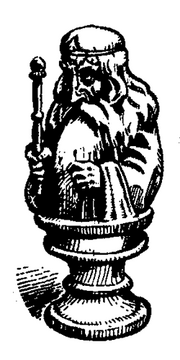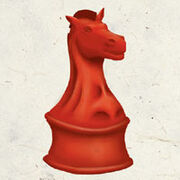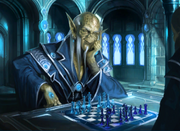Chess was a board game and "one of the four universal games" of Faerûn along with draughts, dice, and Talis.[3] The game was also known as lanceboard or castles;[1][2] lanceboard was considered a variant of chess.[5]
Description[]
In Faerûn, chess was played on a checkered board with thirty-two pieces of six types: pawns, rooks (or castles), knights-errant (or knights), priests (or bishops), queens, and kings.[4][6] The board was the same as that used in the simpler game of draughts/checkers,[7] and was called a chess board or lanceboard.[8] They usually came with the board in a wooden case.[4]
Rules[]
The knight piece was known for jumping directly between squares.[9]
There were regional variations to the rules. In Calimshan, a piece must be moved once it had been touched, but that rule was not used in Cormyr.[10] In Cormyr, a player needed to announce their move out loud[11][12] but this could be neglected.[13] In Cormyr, the black king piece was sometimes termed "Gondegal" after the rebel would-be king of 1352 DR.[13]
There were many named tactics, such as the Theskan double-counter gambit.[14]
Sets[]

A black king piece carved from ebony, from Aurora's Standard Set.
While the more common and cheaper chess sets were made of carved and dyed wood or painted clay, finer sets were often made of more exotic materials. These included ivory for the white pieces and ebony or onyx for the black pieces, and an oiled wooden or even marble board.[4][11][12][15] Alternatively, luspeel (magnetite) could be used so the pieces would have a slight magnetic attraction to a steel chessboard.[6]
Chess sets often used well-known figures, such as rulers or deities, for the king pieces.[4] Others depicted the warriors, priests, and rulers of the land in which they were made,[6] or were inspired by famous historical or recent battles and events.[3][13]
Some noted traditional, specialty, and magical sets were as follows:
- Traditional Set
- This was the most common and oldest form of the game. Typical pieces were hand-carved of ebony and ivory, played on a black and white marbled board, and stored in a padded teak case. In the early 1360s DR, Aurora's Emporium sold these for 20 gp.[3]

A white king piece depicting the wizard Elminster, from Aurora's Avatar Set.
- Avatar Set
- The Avatar Set available from Aurora's Emporium in the early 1360s DR was made of hardwoods from around Loudwater finely carved to resemble figures from the Time of Troubles of 1358 DR. They were reduced to 15 gp in a special clearance following mysterious warehouse fires.[3]
White Black King Elminster Cyric Queen Mystra Razor's Edge

A black king piece depicting King Azoun IV, from Aurora's Horde Set.
- Horde Set
- Also available from Aurora's Emporium in the early 1360s DR, the limited-edition Horde Set made with special permission from the kingdom of Cormyr commemorated the defeat of the Tuigan Horde in 1360 DR. Pieces were made from stone and gilded iron with life-like and flattering depictions of the common soldiers and leaders. Sold for 25 gp, it was popular with lesser Cormyrean nobles and encouraged them to learn the game.[3]
White Black King Yamun Khahan Azoun IV Queen Horde leader Alusair Other Pieces Tuigan horsemen Vangerdahast
- Witch Lords Set
- This unnamed set kept in an antechamber in Castle Obarskyr in Suzail, Cormyr, around 1369 DR was inspired by the battles between the Glory of Cormyr and the Witch Lords in 900 DR. The white pieces were carved of moonstone with good likenesses of the figures depicted.[13]
White Black King Galaghard III Witch-King Rook Turrets bearing arms of Arabel and Marsember Turrets Bishop Death-priests Pawn Purple Dragon knights Bat-riding wizards
- Magical Chessman of Ultham-Urre
- The Magical Chessmen of Ultham-Urre was a set of chess pieces that were themselves magical artifacts with an array of powers. Made from luspeel, each was uniquely carved to resemble a lifelike Chessentan citizen, inlaid with jacinths for a red set and beljurils for a green set. In particular, those who used them would be transformed into the figure depicted, while the rooks turned into instant fortresses.[6]
Red Green King Fighter Ranger Queen Mage Mage Bishop Cleric Druid Knight Fighter Ranger Pawn Thief Fighter
Reputation[]
According to Aurora, chess was considered the most challenging and interesting of the four "universal" games. It was said that rulers waged war with their armies in the summer, and practiced war with chess in the winter. She called it the "king of games" and the "game of kings".[3] Money could be won on games of chess.[15]
In the mid-to-late 14th century DR, chess was known to be played across Faerûn, in Cormyr,[16] in Elmwood and Voonlar in the Moonsea lands,[17] and at the Mithrest Inn in Athkatla in Amn.[18] Chess was also played in the taverns, inns, and clubs of Ravens Bluff in the Vast, such as The Salty Dog.[19][20] Master Etcheen's Chess Shop in Ravens Bluff sold a variety of finely crafted chess-sets, some of which were treated as artworks.[15] The lanceboard variant was popular at the House of the Moon temple in Waterdeep around 1370 DR.[5]
Hermit alaghi enjoyed chess, among other games of strategy. They were likely the best chess players one could find on Toril.[21]
Even devils played chess; Asmodeus and Rumjal once enjoyed playing together.[22] Death was also no obstacle to a love of the game—the ghost of Seiringlast of Seiringlast House in Ravens Bluff would apparently replace the chess-set and play with another spirit.[23]
There were a number of books written just on how to play and master chess.[13] One was Chess Variations of the Masters of Old Impiltur.[14]

A red knight-errant chess piece and the holy symbol of the goddess Red Knight.
The Red Knight, the goddess of strategy and titled the Grandmaster of the Lanceboard, used a red knight-errant piece as her holy symbol and named her sword Checkmate. She showed her favor by manifesting chessboards, red chess pieces, and even stone guardians in the shape of chess pieces. Her chapels used such chess imagery and even life-sized lanceboards, and the clergy held day-long chess tournaments on the Queen's Gambit festival on Tarsakh 1.[8][1] The clergy used the spell knight's move inspired by the knight-errant piece.[9]
The Chessmen of Valsprendar was a circle of eleven standing stones marking a burial site in the hamlet of Wright's Ferry in the Dalelands. They were named for the game of chess.[24]
History[]
The game known as chess, lanceboard, or castles was apparently based on the ancient elven board game of Coroniir, or "crowns" in Common. Lilianviaten Dlardrageth felt that humans had brutalized what elves had invented, as with most great things.[2]
Chess was known in Chessenta (no relation) around the 10th century DR. For example, during the reign of King Tchazzar (929–1018 DR), the archmage Ultham, son of Urrekanam, spent many hours playing chess with the elders of the village of Oslin, and created the Magical Chessmen of Ultham-Urre to protect his friends there before he journeyed into the planes. For several years, they were just used as simple chess pieces.[6]
Chess was known in Cormyr by around 1200 DR.[25]
Some time in the 1300s DR, in The Salty Dog tavern in Ravens Bluff, the mage Mastraero of Calaunt lost at chess to an unwashed sailor and in his rage turned every witness into a snail. But he missed his opponent, Ambassador Carrague, who promptly restored everyone's proper forms, and they got their revenge.[20]
In the Year of the Prince, 1357 DR, King Theris of Mourktar in Threskel held athletic competitions to choose his successor. Alongside archery, boxing, charioteering, discus, jumping, riding, running, swimming, and wrestling, chess was one of the events.[26]
In the Year of the Turret, 1360 DR, in Cormyr, Vangerdahast and Dimswart played in Castle Obarskyr whilst discussing the Tuigan incursion with King Azoun.[11]
In the Year of the Gauntlet, 1369 DR, War Wizards Huldyl Rauthur and Kurthryn Shandarn played a game of chess whilst on guard duty in Castle Obarskyr during the abraxus affair and discussed the events of the time over it. Their game was interrupted by Gwennath announcing the death of Baron Thomdor Ammaeth. Huldyl surrendered when Kurthryn checked his king. Unknown to them, the Harper Emthrara Undril was shapeshifted as the white queen piece.[13][27] Azoun played with Giogioni Wyvernspur afterward, but won each time despite Giogi's tactics and research.[14]
Notable Chess Players[]

It's foolish to run the risk of going mad for Vlaakith's sake.
- Marbol Etcheen, former military advisor to Azoun IV, master chess player, and owner of Master Etcheen's Chess Shop. He played chess with people all around Faerûn and won a lot of money.[15]
- Helyos, a mercenary of Akanax, was a skilled chess player and contender at King Theris's games.[26]
- Lord Mahmud Biinazol, a minor noble of Tethyr, was a fanatic for the game.[28]
- Tordon Sureblade, Lord Magistrate of Ravens Bluff, a master of chess[29]
- King Azoun IV and Queen Filfaeril of Cormyr were known to play chess against each other; Filfaeril usually beat Azoun[30] but then, Azoun never planned his moves but just went with his whims and usually got it right[14] but she knew he was reluctant to sacrifice a piece.[12]
- King Pryntaler of Cormyr and Eltrym Drauthglas played chess together often.[25]
- Buorstag Hlammythyl and Gormstadd of Voonlar met and played chess twice a week.[17]
- Thoyana Jorgadaul and Alamarayne Moonray of Elmwood played each other once a week.[17]
- Mayor Tobald of Ghars in Cormyr, and Grodoveth, envoy of Azoun, played chess whenever Grodoveth lodged at Tobald's house while in Ghars; Tobald believed Grodoveth was as good as anyone in the village.[31]
- The brass dragon Ileuthra, who became so great at the game that no mortal players could challenge him, so he challenged the god of knowledge Oghma to a game and won. The two became regular players.[32]
- Gale Dekarios enjoyed playing the game and was highly proficient at it. He could easily tell what each player's best moves might be just after a quick glance at the chessboard.[33]
Appendix[]
Appearances[]
Adventures
Novels & Short Stories
Video Games
Organized Play & Licensed Adventures
External Links[]
References[]
- ↑ 1.0 1.1 1.2 Eric L. Boyd, Erik Mona (May 2002). Faiths and Pantheons. Edited by Gwendolyn F.M. Kestrel, et al. (Wizards of the Coast), pp. 103–104. ISBN 0-7869-2759-3.
- ↑ 2.0 2.1 2.2 2.3 Erik Scott de Bie (September 2011). Shadowbane. (Wizards of the Coast), loc. 1734. ISBN 978-0-7869-5935-8.
- ↑ 3.0 3.1 3.2 3.3 3.4 3.5 3.6 Jeff Grubb, Julia Martin, Steven E. Schend et al (1992). Aurora's Whole Realms Catalogue. (TSR, Inc), p. 112. ISBN 0-5607-6327-2.
- ↑ 4.0 4.1 4.2 4.3 4.4 Ed Greenwood, Sean K. Reynolds, Skip Williams, Rob Heinsoo (June 2001). Forgotten Realms Campaign Setting 3rd edition. (Wizards of the Coast), p. 96. ISBN 0-7869-1836-5.
- ↑ 5.0 5.1 Eric L. Boyd (September 1997). Powers & Pantheons. Edited by Julia Martin. (TSR, Inc.), p. 161. ISBN 978-0786906574.
- ↑ 6.0 6.1 6.2 6.3 6.4 Ed Greenwood, Eric L. Boyd (1996). Volo's Guide to All Things Magical. (TSR, Inc), pp. 97–99. ISBN 0-7869-0446-1.
- ↑ Jeff Grubb, Julia Martin, Steven E. Schend et al (1992). Aurora's Whole Realms Catalogue. (TSR, Inc), p. 113. ISBN 0-5607-6327-2.
- ↑ 8.0 8.1 Eric L. Boyd (September 1997). Powers & Pantheons. Edited by Julia Martin. (TSR, Inc.), pp. 44–46. ISBN 978-0786906574.
- ↑ 9.0 9.1 Eric L. Boyd (September 1997). Powers & Pantheons. Edited by Julia Martin. (TSR, Inc.), p. 47. ISBN 978-0786906574.
- ↑ Ed Greenwood, Jeff Grubb (April 1998). Cormyr: A Novel. (TSR, Inc.), chap. 19, p. 286. ISBN 0-7869-0710-X.
- ↑ 11.0 11.1 11.2 James Lowder (January 1991). Crusade. (TSR, Inc), chap. 1, pp. 1–3, 9, 14. ISBN 0-8803-8908-7.
- ↑ 12.0 12.1 12.2 James Lowder (January 1991). Crusade. (TSR, Inc), chaps. 3, Epilogue, pp. 49–50, 311. ISBN 0-8803-8908-7.
- ↑ 13.0 13.1 13.2 13.3 13.4 13.5 Ed Greenwood, Jeff Grubb (July 1996). Cormyr: A Novel. (TSR, Inc.), chap. 19, pp. 255–265. ISBN 0-7869-0503-4.
- ↑ 14.0 14.1 14.2 14.3 Ed Greenwood, Jeff Grubb (July 1996). Cormyr: A Novel. (TSR, Inc.), chap. Epilogue, pp. 433–434. ISBN 0-7869-0503-4.
- ↑ 15.0 15.1 15.2 15.3 Ed Greenwood (October 1998). The City of Ravens Bluff. Edited by John D. Rateliff. (TSR, Inc.), p. 126. ISBN 0-7869-1195-6.
- ↑ Ed Greenwood (July 1995). Volo's Guide to Cormyr. (Wizards of the Coast), p. 161. ISBN 0-7869-0151-9.
- ↑ 17.0 17.1 17.2 John Terra (January 1995). “Reference Guide”. In Allison Lassieur ed. The Moonsea (TSR, Inc.), pp. 22, 51. ISBN 978-0786900923.
- ↑ BioWare (September 2000). Designed by James Ohlen, Kevin Martens. Baldur's Gate II: Shadows of Amn. Black Isle Studios.
- ↑ Ed Greenwood (October 1998). The City of Ravens Bluff. Edited by John D. Rateliff. (TSR, Inc.), p. 11. ISBN 0-7869-1195-6.
- ↑ 20.0 20.1 Ed Greenwood (October 1998). The City of Ravens Bluff. Edited by John D. Rateliff. (TSR, Inc.), p. 136. ISBN 0-7869-1195-6.
- ↑ David Cook (1991). Monstrous Compendium Forgotten Realms Appendix (MC11). (TSR, Inc), p. 4. ISBN l-56076-111-3.
- ↑ Ed Greenwood (November 1984). “Nine Hells revisited”. In Kim Mohan ed. Dragon #91 (TSR, Inc.), p. 24.
- ↑ Ed Greenwood (October 1998). The City of Ravens Bluff. Edited by John D. Rateliff. (TSR, Inc.), p. 120. ISBN 0-7869-1195-6.
- ↑ Ed Greenwood (January 1996). Volo's Guide to the Dalelands. (TSR, Inc), p. 126. ISBN 0-7869-0406-2.
- ↑ 25.0 25.1 Ed Greenwood (March 2001). “The New Adventures of Volo: Lost Treasures of Cormyr, Part 4”. In Dave Gross ed. Dragon #281 (Wizards of the Coast), p. 76.
- ↑ 26.0 26.1 Scott Bennie (February 1990). Old Empires. Edited by Mike Breault. (TSR, Inc.), pp. 67–68, 70. ISBN 978-0880388214.
- ↑ Ed Greenwood (October 2000). “The New Adventures of Volo: Cormyrian Contracts”. In Dave Gross ed. Dragon #276 (Wizards of the Coast), p. 77.
- ↑ Steven E. Schend, Sean K. Reynolds and Eric L. Boyd (June 2000). Cloak & Dagger. (Wizards of the Coast), p. 107. ISBN 0-7869-1627-3.
- ↑ Ed Greenwood (October 1998). The City of Ravens Bluff. Edited by John D. Rateliff. (TSR, Inc.), p. 71. ISBN 0-7869-1195-6.
- ↑ Ed Greenwood, Jeff Grubb (July 1996). Cormyr: A Novel. (TSR, Inc.), chap. 11, pp. 151–152. ISBN 0-7869-0503-4.
- ↑ Chet Williamson (July 1998). Murder in Cormyr. (TSR, Inc.), chap. 14, p. 84. ISBN 0-7869-0486-0.
- ↑ Nigel Findley, et al. (October 1990). Draconomicon. Edited by Mike Breault. (TSR, Inc.), p. 40. ISBN 0-8803-8876-5.
- ↑ Larian Studios (October 2020). Designed by Swen Vincke, et al. Baldur's Gate III. Larian Studios.
